I have a captured data set from a linear position sensor, shown below that I would like to query. The pandas dataframe I have imported has columns including the linear position sensor data as well as additional columns of data. As the data is a signal acquired via a DAC it is not smooth (noise) and the values are not known (sample rate). I would like to be able to query the dataframe to report the time and position of the linear position sensor as started to move; (about 1.8 seconds in the below) and again report the time and linear position just before impact (about the 2.08sec mark).
Data from the first 5 rows:
Time Ch0_LC1 Ch1_LC2 Ch2_LC3 Ch3_Posi Ch4_Accel LC1_Cal
1 0.0000 -0.001179 0.015223 -0.013722 4.755466 4.670560 -0.009261
2 0.0001 -0.001822 0.016188 -0.012114 4.754823 4.676027 -0.002510
3 0.0002 -0.001179 0.016188 -0.012757 4.754501 4.680208 -0.009261
4 0.0003 -0.000858 0.016509 -0.015008 4.754823 4.683746 -0.012632
5 0.0004 -0.001179 0.016188 -0.013400 4.755466 4.686962 -0.009261
LC2_Cal LC3_Cal LC_Tot Posi_Cal Accel_Cal Posi_Vel
1 0.014619 -0.002637 0.002721 1422.726220 -1.067844 0.0000
2 0.004876 -0.018576 -0.016209 1422.845175 -0.958777 0.4825
3 0.004876 -0.012202 -0.016587 1422.904745 -0.875366 0.0000
4 0.001636 0.010111 -0.000886 1422.845175 -0.804783 -0.4825
5 0.004876 -0.005829 -0.010213 1422.726220 -0.740624 -1.1255
Where the Chx columns are direct DAC data, the _Cal columns have been corrected for calibration and the final _Vel column is a double derivative of the position for instant velocity.
There are examples of the query function and the .loc function being used for this type of data reporting when values are exactly equal to the query, but I can't get the same method to work with a < argument, as it returns all subsequent samples. E.g. Select rows from a DataFrame based on values in a column in pandas
If anyone could assist it would be much appreciated.
Link to DSP file: https://www.dropbox.com/s/z9xs3te23xet1lz/R16-03_moving.dat?dl=0
Code snippet for importing the above file and creating the additional columns.
from IPython import get_ipython
get_ipython().magic('reset -sf')
import numpy as np
import matplotlib.pyplot as plt
import scipy.fftpack
import pandas as pd
#from scipy import interpolate
from scipy.interpolate import splrep, splev
from scipy.signal import butter, filtfilt, freqz, sosfiltfilt, sosfilt, cheby2, sosfreqz
Start_line = 15
file = 'C:/Users/wesley.heckendorf/Downloads/R84-02_moving.dat'
output1 = pd.read_csv(file, "r", delimiter=' ', skiprows=Start_line, usecols=[0,1,2,3,4,5], error_bad_lines=False)
#io = pd.read_csv('D:/UCRF_Drop_Commissioning/16.run/R16-03_moving.dat', "r", delimiter=' ', skiprows=21, index_col=False, usecols=[1,2,3,4,5]).to_records() # To read 1st,2nd columns
io2 = pd.read_csv(file, "r", delimiter=' ', skiprows=(Start_line+7), index_col=False, names=['Time', 'Ch0_LC1', 'Ch1_LC2', 'Ch2_LC3', 'Ch3_Posi', 'Ch4_Accel']) # To read 1st,2nd columns
io2[:] = io2[:].convert_objects(convert_numeric=True)
"""constants"""
T = (io2.loc[2,'Time'] - io2.loc[1,'Time'])
fs = 1/T
nyq = 0.5 * (1/T)
""" Extract Calibration Factors and create columns for calibrated and Zero'd data"""
LC1_cal = float(output1.iloc[2,1])
LC2_cal = float(output1.iloc[2,2])
LC3_cal = float(output1.iloc[2,3])
Posi_cal = float(output1.iloc[2,4])
Accel_cal = float(output1.iloc[2,5])
print (LC1_cal, LC2_cal, LC3_cal, Posi_cal, Accel_cal)
io2["LC1_Cal"] = (io2["Ch0_LC1"]-float(output1.iloc[1,1])) * LC1_cal
io2["LC2_Cal"] = (io2["Ch1_LC2"]-float(output1.iloc[1,2])) * LC2_cal
io2["LC3_Cal"] = (io2["Ch2_LC3"]-float(output1.iloc[1,3])) * LC3_cal
io2["LC_Tot"] = (io2["LC1_Cal"]+io2["LC2_Cal"]+io2["LC3_Cal"])
io2["Posi_Cal"] = ((io2["Ch3_Posi"] - io2["Ch3_Posi"].max())-float(output1.iloc[1,4])) * Posi_cal * -1
io2["Accel_Cal"] = (io2["Ch4_Accel"]-float(output1.iloc[1,5])) * Accel_cal
io2["Posi_Vel"] = (np.nan_to_num(np.gradient(io2["Ch3_Posi"]/-10,T)))
print (io2[1:6])
